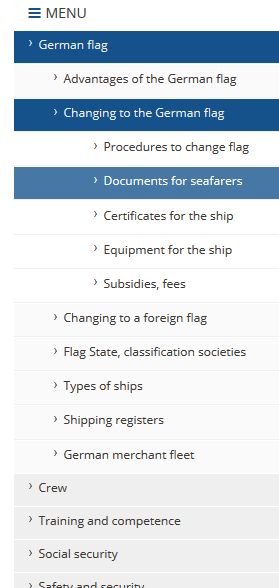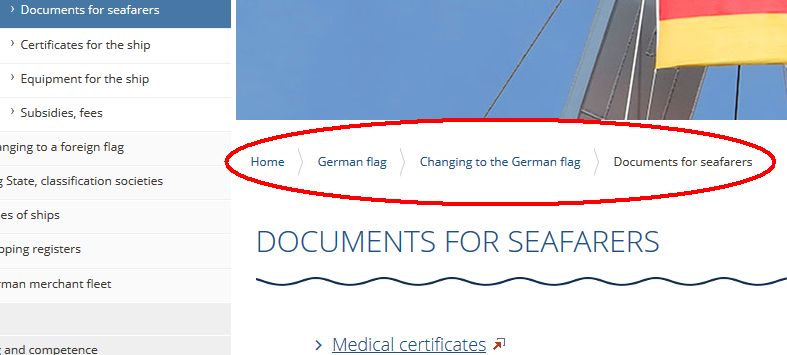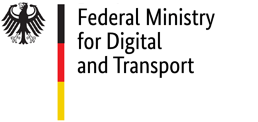Easy language
Welcome!
You are on the internet pages
of the state-run administration
for seagoing ships flying the German flag.
Many authorities
have put their information on these pages.
Everything you need to know about
shipping under German flag
is on these pages.
There are seagoing ships and inland vessels.
Seagoing ships travel the oceans and along the coasts.
Inland vessels travel on canals, rivers and lakes.
We take care of the safety of seagoing ships.
But only seagoing ships from Germany.
These ships fly the German flag.
We make sure these seagoing ships are safe.
We make sure that seafarers have
good working conditions on board.
The working hours need to be followed.
The work place has to be tidy and in good repair.
Seafarers have to be paid on time.
We make sure that the living conditions
of seafarers are good too.
Seafarers live on board the ship.
Their rooms have to be tidy.
They need to get enough to eat and drink.
We want to explain these topics
in a way you understand easily.
We want many people to read and
understand our internet pages.
You are totally or partially deaf?
Please click on the word DGS at the top right of this page.
DGS means German sign language.
You can watch a video in German sign language.

Do you want to read our pages in German?
At the top right you can find a German flag.
A click on it will lead you to our internet pages in German.

What else is at the top right of the page?
Other than the buttons dealing with language options,
there are three buttons to click on at the top right:

- Many organizations deal with shipping
not just us, the German Flag State Administration.
Maritime links lists these organizations.
When you click on the name of the organization
you will get to the internet pages of it. - FAQ stands for Frequently asked questions.
This is where we give answers to questions
about the internet pages. - The Feedback button leads you to a page
where you can write us an e-mail
if something doesn't work well
on these internet pages.
Three important buttons:

- The red Emergency button leads you to a page
that explains what a seafarer needs to do
in case of an emergency.
Every emergency on board a ship
requires the seafarer to call a particular place.
Who does he have to call in case of an accident?
And who in case the ship is in danger?
When he calls the right place
he will get the help he needs quickly. - The blue button leads to our 24/7 Hotline numbers.
You can call by day and by night.
We are always available. - With the grey button Newsletter
you can register for our newsletter.
You can read older newsletters too.
You want to get back to the start?
Our home page is the first page.
Click on the logo to get back to the start.

This is how you find information:
You are looking for information.
But you cannot find it on our pages.
Use our search function.
Put in the word that you are looking for
in the box next to the magnifying glass.
Click on the magnifying glass.
You will be given a list of places
where this word occurs on our pages.

Navigation on the left
On the left hand side under menu
are the topics of the German flag.
Click on the topic that interests you.
Oftentimes when you click on one topic
more topics that belong to the topic will flip open.
These can be chosen with a click too.
Our main topics are:

The blue blocks in the menu
show you where you are at the moment.

This is what the topics tell you about:
- The heading German flag tells you
why ships are so safe under German flag.
We tell you how a ship can get the German flag. - In Crew we tell you about seafarers.
We say what seafarers can and cannot do.
We tell you about life and work on board a ship. - Under the heading Training and competence
we tell you what a seafarer needs to learn to work on a ship.
Seafarers have to be trained well
so that ships are safe. - Under Social Security you can read about
insurances for seafarers.
A health insurance pays for the treatment when a seafarer falls ill.
An unemployment insurance pays when he looses his job.
When he is ready to retire, the pension insurance pays.
There are some more important insurances. - Then you can read all about Safety and security for ships.
We tell you about the technologies that keep ships safe and secure.
And how to safeguard from pirates.
Cargo has to be loaded and transported safely.
Seafarers learn how to save someone after an accident
and how to prevent accidents from happening. - The heading Maritime medicine deals with sick seafarers.
And with healthy ones.
Sick seafarers should get well quickly.
Only very few ships have a doctor.
That is why we teach seafarers how to help.
Everyone who wants to go to sea is examined by us first.
We check if the person is able to do the hard work on board. - With the topic Environmental protection
we explain how to protect the environment.
Seafarers must not throw their rubbish over board into the water.
We make sure that chimneys do not pipe out toxic smoke.
If a ship is old and broken,
it cannot simply be sunk somewhere.
We take extra care when ships transport dangerous cargo. - Liability has to do with insurance.
An example:
A ship owner lets a ship sail that is far too old.
The ship sinks.
The ship owner has to pay for anything that the ship broke
while it was sinking.
If the ship damaged another ship,
he has to pay to have it repaired.
If the ship leaked oil into the water,
he has to pay to have the water cleaned.
All of this costs a lot of money.
Insurances help to pay so much money at once. - The heading Financial matters deals with money.
We show how the state helps people who own ships.
They have to pay very little tax for their ships, for example.
The state gives money when they train seafarers on their ships. - Our Port State Control officers check
if all the rules on board the ships are kept.
When a ships is not safe,
it may not leave the port.
It is put in chains.
At the bottom of the page is a blue wave.
All of these topics are listed there again.
This is on the blue bar:
The German flag service topics are given on the blue bar.

When you put the arrow on a topic,
the topics belonging to this main topic flip open.
Click on the topic that you want to choose.

This is what the service topics are all about:
- Latest information gives you current but also older information.
You can find job offers at the authorities of the German flag. - Click on Contact details to find
a contact person for a topic.
You are given the postal address, telephone number and e-mail address.
Sometimes it is urgent.
You can call the hotline day and night.
Under this heading we also explain what each authority does. - Under our heading Applications & documents
you can find forms, applications and many files
to download onto your computer.
This is all sorts of information
that is important for shipping under German flag.
Click on the topic that interests you. - Under Certificates and verification
the master of a ship or the ship owner
can check which certificates a ship or a seafarer needs.
He can check how much the certificates cost.
And if the certificates are the real ones.
The certificates proof that a ship is safe to travel
or that a seafarer is doing well on board the ship. - Look under Training to find training place on board a ship.
You can find out how much money the state will give
for the training places on board ships.
Bread-crumbs-navigation (also called click path)
If you don't remember which topic you are reading in at the moment:
You can find out in the line underneath the big picture.
The name bread-crumbs-navigation comes from a fairy tale
where children leave bread crumbs behind
on their way into the forest
to find their way back again later.
The topics listed next to each other
are your trail back to the home page.


